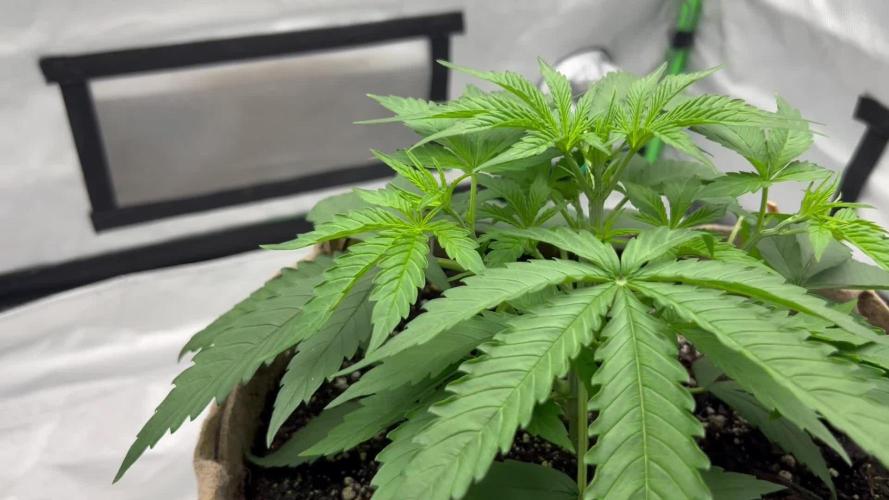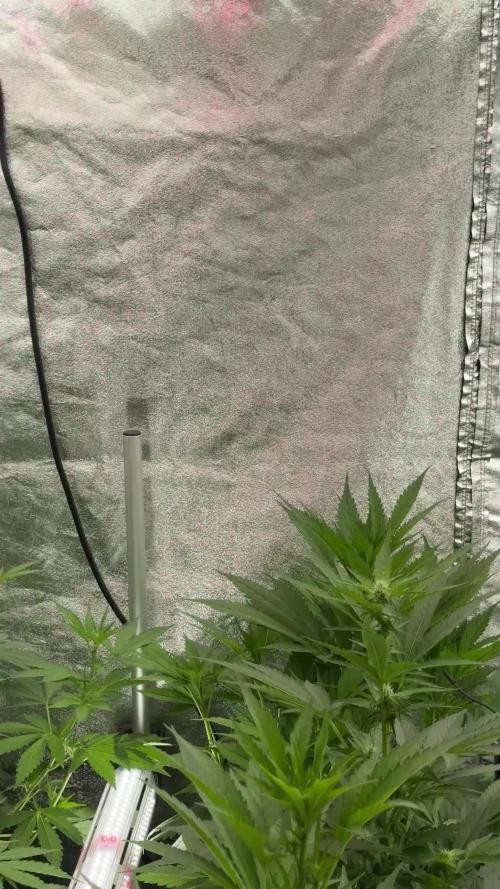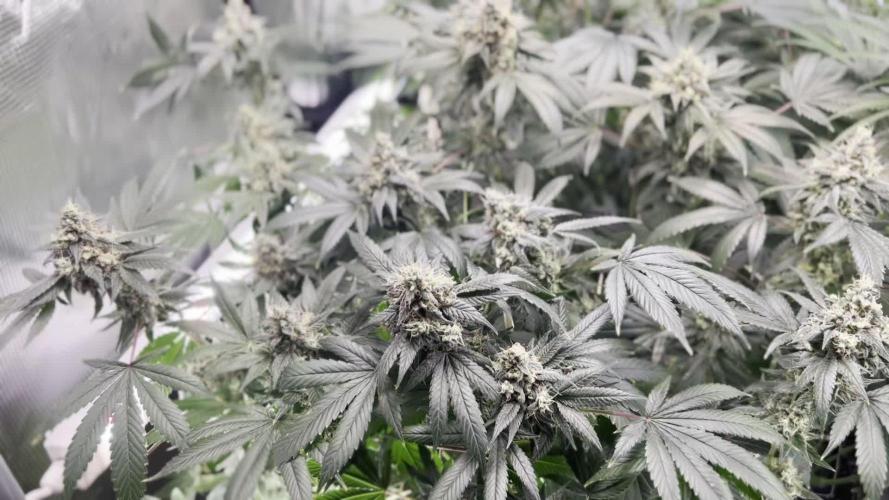The Grow Awards 2026 🏆 

































Processing
Likes
Comments
Share


@Master_weeda
Follow
Bonjour à tous les padawans et maîtres jedis
Pour cette semaine je commence le rinçage car les trichomes sont bien laiteux
Arrosage avec 2 litres d'eau ph6.3 à chaque fois que le pot est léger
Likes
1
Share


@sanibelisl
Follow
Day 21, three weeks old today and she is running on full steam ahead. Room temp is 78 and the humidity is about 55, she seems to like it there. She stands a stout 7 inches tall with satellite branches that match creating a terrific natural canopy. She was watered this morning with plain ph adjusted water.
*** Day24***
Wow! What a little dynamo she is. So literally an inch a day. Satellite branchyare going to be the same height as the main stem. She’s starting showing pistils today so I’m getting close to stretch.
***Day 26***
She sure is pretty!
Likes
7
Share


@stonermamba13
Follow
2nd week of 12-12, last massive defoliations and LST before the bloom.
I’ll attend about 10 days and pre flower for others stress.
Let’s do it, let’s flowering!
Likes
126
Share


@DogDoctorOfficial
Follow
Wow what an amazing girl this is, from her slow start to were she is now , i mean colors all over the place , its like all fruits are starting to change , and the smell OMG its like a candy that we must eat over and over again hehehe
And as the week keeps moving she keeps evolving i mean just amazing no other words do describe what i am felling with this mama
Decided to stop all feedings as the week moves along and since that by the looks this one as mb a week or so to be ready, not longer i believe lets see all i know is that for me she is already a winner and she is not yet done, i mean look at them trichomes , look at them colors formation, numbers i mean you name it and this girl has it on her bag appeal, praying for her to be great medicine with i already know she will be, oh and congratulations FAST BUDS on the winning on the autoflower cup that just happened , much respect guys
and as the week comes to an end almost, i am amazed with how much she changed in just a week, her color is completely different all over her, not a bud here or there but all of them all over , loving it much respect, great creation this one
As always thank you all for stopping by and for supporting me on this journey, i am super passion about growing and fell blessed to have you all with me on this new journey <3 <3 <3
Genetics - Fast Buds Banana Purple Punch
Ligth - LUMATEK ZEUS 465 COMPACT PRO
Food - APTUS HOLLAND
All info and full product details can be find in can find @
https://2fast4buds.com/
https://aptus-holland.com/
https://autopot.co.uk/
https://lumatek-lighting.com/
<3 <3 <3 Growers love to you all <3 <3 <3
Note, i will update ASAP but the Valentine contest dates are closing so i had to update the pictures this week, i will move them to the next and harvest one , growers love to you all <3<3<3
Likes
72
Share


@Roberts
Follow
I am starting Auto Maxi Gom. I scuffed the seed lightly, and placed her in a glass of water. She will be in there for 24 to 48 hours. Basically once I see a root tail start I will drop her in the coco. I will dome her and keep moist. She will be under a Medic Grow Mini Sun-2. She will be in Xpert nutrition. Thank you Medic Grow, Seeds Mafia, and Xpert nutrition. 🤜🏻🤛🏻🌱🌱🌱
Update: first seed appeared to be a dud or just really slow to germinate. I started a second seed, and it went right away.
Thank you grow diaries community for the 👇likes👇, follows, comments, and subscriptions on my YouTube channel👇. ❄️🌱🍻
Happy Growing 🌱🌱🌱
https://youtube.com/channel/UCAhN7yRzWLpcaRHhMIQ7X4g
Likes
5
Share


@CanarianGrow92
Follow
Too much N is observed and also some heat as there is an heatwave again and inside the tent it was around 31 c°, i only used half dosis of iguana grow in a light mix and it still seems to be too much, the ppm was around 380 so not sure if its just heat stress, but i think they will be fine, i will just only give water the next week and apply some slow absorbing nutrients on the top of the soil, something like guanokalong or biobloom, im sure they will be fine 😁
Likes
9
Share


@ArizonaJonezz
Follow
Buds are fattening up nicely. Hairs are slowly turning orange. Drinking a lot of water lately
Likes
21
Share


@Siriuz
Follow
Started Week 10
Day 64
Fed them some nutes
Day 65
Looking good
Day 66
Outdoors for 3 hrs in the morning due to blackout T_T
Rested like 6hrs zZzz no lights
Day 67
Back to 20/4 schedule
Everything is good
Day 68
Lil defoliation
Got some pics and videos for you all
Day 69 Cool Juicy Video
Day 70 End of week 10
Overrall she is great!
Plan on to give her last meal tomorrow
Floranova bloom
Likes
36
Share


@MadeInGermany
Follow
Info:
Unfortunately, I had to find out that my account is used for fake pages in social media.
I am only active here on growdiaries.
I am not on facebook instagram twitter etc All accounts except this one are fake.
Have fun with the update.
Hey everyone 😀.
Another nice week goes by with a great development :-).
Next week it will be placed in the flower chamber with a time interval of 12/12 hours.
1 g of GHSC enhancer was added per liter of water.
I sprayed neem oil again as a preventive measure, hence the dark shine :-)
The tent was completely cleaned and the humidifier was refilled.
I wish you all the best 🙏🏻
You can buy this Strain at :
https://originalsensible.com/original-sensible-seeds-zkittlez~20503
Type:
Zkittlez
☝️🏼
Genetics:
Afghan Kush Indica x Grandaddy Purple x Grapefruit hybrid
👍
Vega lamp:
2 x Todogrow Led
Quantum Board 100 W
💡
Bloom Lamp :
2 x Todogrow Led
Cxb 3590 COB 3500 K 205W
💡💡☝️🏼
Soil :
Canna Coco Professional +
☝️🏼
Fertilizer:
Green House Powder Feeding
☝️🏼🌱
Water:
Osmosis water mixed with normal water (24 hours stale that the chlorine evaporates) to 0.2 EC. Add Cal / Mag to 0.4 Ec Ph with Organic Ph - to 5.5 - 5.8 .
Likes
20
Share


@DogDoctorOfficial
Follow
🌸 Grow Diaries – Permanent Marker, Week 2 Flower 🌸
This week is special on many levels. Not only are our Permanent Marker queens thriving in their second week of flower, but it’s also a milestone for the Dognabis Cup: the welcome packs are on their way! So everyone, stay tuned to the postman and the doorbell — good things are coming. ✉️📦
The Cup itself is more than just a grow, it’s a celebration. It’s about sharing knowledge, experiences, and love for the plant. It’s about learning together, lifting each other up, and creating a space where everyone feels welcome. Sharing is caring, and this Cup is built on that principle. I’m truly honored to be creating this, and I hope all participants enjoy the ride.
On the nature side 🌍🐝, I want to pause for a moment to appreciate the bees. They are true lifesavers for our planet, silent workers who ensure our ecosystems flourish. Just like automation in the grow room helps us, bees are nature’s perfect automation for life itself.
Speaking of automation 🤖💧, this week we introduced a watering system to see how it supports the garden. We may or may not keep it, but for now, it’s been running, helping maintain consistency while still letting us keep a close eye on the girls.
Now, the stars of the show, the Permanent Marker phenos. Both are growing beautifully, very similar in structure, with Pheno #1 stretching just a touch taller. Compact yet strong, stacking beautifully, and already showing promise of what’s to come. Alongside them, the whole room is thriving, and I’ve shared a video to give you all a glimpse of the bigger picture. 🌿
Lighting is another key topic this week: I want to highlight the ThinkGrow ICL 300 inner canopy lights. With their 300° spread, they make sure that even the lower canopy gets love, pushing light deep into the structure. This tech is a game-changer in keeping plants balanced and productive from top to bottom.
Nutrition-wise, we keep it simple because the super soil is already alive and working hard. We’re just giving the girls a push with Aptus Holland Regulator and a gentle dose of Top Booster. Nothing more is needed, they are thriving in their living soil environment.
🌸 Summary:
• Stage: Week 2 of flower, steady stretch and stacking.
• Nutrition: Super soil base + Aptus Holland (Regulator + caMag-Boost + Top Booster).
• Automation: Watering system introduced this week.
• Lighting: ICL 300 bringing life to the under-canopy.
• Dognabis Cup: Welcome packs shipping out 🎉 — sharing is caring.
• Inspiration: Remember the bees 🐝 — life’s greatest little allies.
📲 Don’t forget to Subscribe and follow me on Instagram and YouTube @DogDoctorOfficial for exclusive content, real-time updates, and behind-the-scenes magic. We’ve got so much more coming, including transplanting and all the amazing techniques that go along with it. You won’t want to miss it.
• GrowDiaries Journal: https://growdiaries.com/grower/dogdoctorofficial
• Instagram: https://www.instagram.com/dogdoctorofficial/
• YouTube: https://www.youtube.com/@dogdoctorofficial
⸻
Explore the Gear that Powers My Grow
If you’re curious about the tech I’m using, check out these links:
• Genetics, gear, nutrients, and more – Zamnesia: https://www.zamnesia.com/
• Environmental control & automation – TrolMaster: https://www.trolmaster.eu/
• Advanced LED lighting – Future of Grow: https://www.futureofgrow.com/
• Root and growth nutrition – Aptus Holland: https://aptus-holland.com/
• Nutrient systems & boosters – Plagron: https://plagron.com/en/
• Soil & substrate excellence – PRO-MIX BX: https://www.pthorticulture.com/en-us/products/pro-mix-bx-mycorrhizae
• Curing and storage – Grove Bags: https://grovebags.com/
⸻
We’ve got much more coming as we move through the grow cycles. Trust me, you won’t want to miss the next steps, let’s push the boundaries of indoor horticulture together!
As always, this is shared for educational purposes, aiming to spread understanding and appreciation for this plant. Let’s celebrate it responsibly and continue to learn and grow together.
With true love comes happiness. Always believe in yourself, and always do things expecting nothing and with an open heart. Be a giver, and the universe will give back in ways you could never imagine.
💚 Growers love to all 💚
Likes
74
Share


@Schnabeldino
Follow
_____📅 Week 9 | 📅 🌼🌸🌺flower🌼🌸🌺 ______
🔸Our lady is now entering her third week of flowering – and she's doing so with elegance! The buds are slowly developing volume, the white pistils stand proudly and are beginning to appear denser. The trichomes are becoming increasingly visible and already give her that fine, sugar-like shine. The leaves remain narrow and elegant, typical of sativa-dominant genetics. The reddish stems add beautiful accents – everything points to a healthy plant in full bloom. A real dance begins! 💃.
🔸The dehumidifier now maintains a constant relative humidity of 50-60%, which I am very satisfied with. It does make it 2-3 degrees warmer in the tent, but I can live with that.
🔸Now gets big bud from AN, becomes thirstier
______________________________________________________________________________________
📈 Current Conditions
🌡️🔆 = 27°C
🌡️🌜 = 20°C
💨 VPD Target = 1.4 - 1.6
💨 Humidity = 63% → Target: below 60%
🔦 PPFD = 900 µmol (12/12)
🔦⌚ DLI = ~38
🛠️ Setup (unchanged)
💡 Lights: 2 x Sanlight Evo 4-120 @ 90%
⛺ Tent: 120 x 120 x 180
🍯 Pot Size: 18 liters
🌱 Medium: Bio-Bizz Light Mix
💊 Nutrients: Advanced Nutrients
💧 Water: Tap water (EC 0.5)
Likes
5
Share


@cookingwithninja
Follow
Plants are currently drying
2+ months later. And next project au79
Likes
4
Share


@tangielope
Follow
Ate agora é tudo indo bem, a menina ta lindona.... Se alguem se perguntar porque ela se chama D-jay é em homenagem ao lutador jamaicano do street fighter, quando eu comecei a cultivar dei um nome da cada personagem as plantinhas algumas n foram p frente e deu game over como bison, sagat, E-Honda, ryu e zangief algumas morrem outas eram machos... Acredite autos machos ja tive 3 e eram p ser feminilizadas .. vai entender...
Atualizando .... Ela esta crescendo muito, impressionante com certeza no momento é a rainha do baile...
Processing
Likes
12
Share


@HylianGrass
Follow
Starting 3rd week , we should know soon if im lucky and my strong looking plants are females!
Fingers crosed! 2 out of 4 are looking good one is a slow grower and the other one is all mesed up , i guess the rooting process did not go well for this one ☝️
Likes
62
Share


@MeaCulpa
Follow
4th round.
These were the Special Kush. The buds are very fluffy. Therefore only 83.3g.
But it doesn't matter. I learned so much this grow, it was worth it.
I think the Hulk Berries in 2 days. They're not dry enough yet.
Likes
207
Share


@DogDoctorOfficial
Follow
Last week wen smooth as it is supposed to go, girls are loving the conditions so its time to start feedings, for this run I’m using all in one pallets as food and just watering with Regulator ( a must in my water) and some microbiological help and iff and wen needed, only them i will complement extra N, P or K as needed.
Caps off to VIPARSPECTRA , so far so great 🌱🙏💚
All going smooth, not much to say, today I changed the gopro setup to a top view , lets see with one stays better on the time-lapse , fell free to comment and leave your opinion, and if you use gopro or other camera to do your time-lapses, i love to learn about others ideas and ways to do things 💚💚💚
You can check out last week timelapse here https://growdiaries.com/diaries/126067-grow-journal-by-dogdoctor and if you in to timelapse stuff i have just recently uploaded the Magnum auto Timelapse just for fun here https://growdiaries.com/diaries/105893-grow-journal-by-dogdoctor , hope you guys enjoy it 💚💚💚 growers love and one more week up we go 🙏🌱💚
And with enormous honor and pleasure that i start collaborating with Zamnezia and Viparspectra
For this run i will have the pleasure of growing some Runtz genetics from Zamnezia seeds that they wore kind enough to send me for test and review 🙏🙏🙏💚💚💚🙏🙏🙏 and for the testing and reviewing i was blessed with the VIPARSPECTRA model P2000💚💚💚🙏🙏🙏 they wore amazing and send me this LED light for me to do some testing and some reviews. Special thanks to Zamnezia and to Viparspectra for this opportunity, lets make magic together 💚💚💚🙏🙏🙏
All i grow is medicine for myself, for me and for my best friend with is me 😆 nothing to sell, so don’t even ask 😅💚💚💚
All info and full product details can be find in can find @
https://viparspectra.eu/collections/grow-lights DISCOUNT CODE - DOGDOCTOR
https://www.zamnesia.com DISCOUNT CODE - GROWITGD
https://aptus-holland.com/
More info and updates @
https://growdiaries.com/grower/dogdoctor
https://instagram.com/dogdoctorofficial
https://youtube.com/channel/UCR7ta4DKLFMg2xxTMr2cpIg
💚💚💚Growers love to you all 💚💚💚
Likes
12
Share


@Growgirl1114
Follow
I have at least 3 weeks to go on this Green Poison, hoping the Ohio weather holds out for me ✌️🌱✌️




















